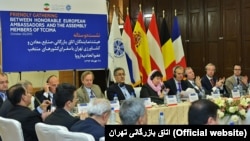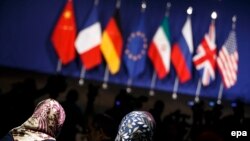The low level of foreign direct investment in Iran indicates that, despite the 2015 nuclear deal, the dark clouds of foreign mistrust still loom over Tehran’s economy, writes Radio Farda analyst Fereydoun Khavand.
The latest annual UNCTAD report on global foreign direct investment (FDI) published on June 7 clearly shows that despite the ratification of the Joint Comprehensive Plan of Action, JCPOA, or Tehran’s nuclear deal with global powers, the volume of foreign investment in Iran is so minimal that it is miles behind the level needed for the country to achieve its economic goals.
The United Nations Conference on Trade and Development (UNCTAD) publishes an important annual report that details the latest developments and data concerning FDI around the globe. The report is considered highly credible among economy experts and academic circles.
Iran’s Frailty in Attracting Foreign Capital
According to UNCTAD’s Experts’ Assessment, the volume of FDI Iran attracted in 2016 was more than $3.4 billion, showing a 64 percent growth in comparison with the previous year.
However, the growth rate is much less than it used to be in 2011 and 2012, when international sanctions imposed on Iran were at their highest point. For example, the volume of FDI in Iran in 2012 amounted to $4.7 billion.
In comparison with the hopes raised by JCPOA, the volume of FDI in Iran seems disappointing. Looking back at the exaggerated statistics presented by a number of sources in Iran, that disappointment is intensified. The sources, in 2016, boasted of more than $11 billion in FDI.
According to UNCTAD’s Experts’ Assessment, the volume of FDI Iran attracted in 2016 was more than $3.4 billion, showing a 64 percent growth in comparison with the previous year.
Apparently, the Iranian institutes in charge of statistics still confuse primary agreements on FDI with genuine and finalized ones. This confusion, indeed, has led to many false hopes.
Depending on the UNCTAD figures, one might ask why Iran lost $1.3 billion in FDI between 2012 and 2016, and why it happened despite JCPOA, as well as dozens of potential foreign investors visiting Iran and President Hassan Rouhani’s efforts to boost Tehran’s interaction with the rest of the world.
Still, based on UNCTAD’s data, it is more disappointing to know that in 2016 Turkey attracted nearly four times as much FDI as Iran. In the same period, the small nation of the United Arab Emirates attracted almost $9 billion in FDI or 2.7 times what Iran achieved in the same time.
Going beyond the region, we have Singapore, with its smaller 6 million population, which attracted $61.6 billion in FDI, or 18 times that of Iran.
Iran’s weakness and frailty in attracting FDI and its inevitable consequences become more evident when weighed against the enormous foreign capital Iran requires for its development.
Most Iranian experts have concluded that the country needs at least a stable annual growth rate of 8 percent to get out of its current plight and solve its persistent high unemployment problem.
To achieve such a growth rate, especially for a long period, Tehran needs massive capital resources, which is hard to imagine in the framework of Iran’s current capabilities.
According to a study by Iran’s High Institute of Education and Research Management and Planning, the country needs $150 billion to $180 billion investment a year ($30 billion to $50 billion from foreign sources) to achieve an 8 percent growth rate, which is needed to make a meaningful dent in unemployment.
Failure in Depicting a New Face
Most Iranian experts have concluded that the country needs at least a stable annual growth rate of 8 percent to get out of its current plight and solve its persistent high unemployment problem.
To understand the importance of these figures, it suffices to know that, according to UNCTAD, the total volume of investments in recent years in Iran has been $48 billion whereas it has been $231 billion in Saudi Arabia and $133 billion in Turkey. Therefore, the question is how Iran can achieve an 8 percent growth rate by attracting the total amount of its foreign capital in recent years, in one single year.
This, of course, does not necessarily mean Iran will never be able to achieve $50 billion in FDI per year.
Achieving such a goal is not an impossible feat. It is, indeed, quite possible if we consider Iran’s potential, including its natural wealth, population, and geographic location. However, transforming potential into reality needs great changes in economic, political, and diplomatic structures as well as policies of the country.
The low figure of FDI clearly shows that despite the significant potential of JCPOA, it has failed in ending Iran-phobia among foreign investors.
Potential investors determine their risk level by a series of legal, economic, and political factors. In all these factors, Iran has failed to show a new and acceptable image to foreign investors.
By relaying a message about placing economic development at the top of its priorities, implementing reforms, and moving toward global markets, Tehran could have used JCPOA as way to create an appropriate atmosphere for relations with global financial circles and particularly international investors.
During the nuclear negotiations, Iran’s executive branch, under Rouhani, hoped to focus on radical economic reforms and offer a new discourse in Iran’s foreign relations once the deal was signed and sanctions lifted.
Nevertheless, a substantial part of Rouhani’s efforts in his first presidential term ended in failure. Currently, there is no sign of fundamental economic reforms in sight. Even his government initiatives for improving the legal environment for attracting foreign capital, including the presentation of more favorable oil contracts to lure major companies into Iran, have not provided the results desired.
The world’s financial circles are undoubtedly aware of the fact that Rouhani, in his second term, will continue the path of reforming Iran’s internal and international policies. But they are not so sure about whether he can neutralize his hard-line opponents.
A significant number of effective economic levers are beyond Rouhani’s reach. Moreover, he has no control over the country’s sensitive foreign relations, which play a crucial role in attracting or discouraging FDI.
During the past four years, it was because of pressure from his detractors that Rouhani lost valuable chances to move toward rapprochement with the United States.
Today, the situation is more hostile than ever as tensions between Tehran and Washington have reached a new high.
Evidently, the continuation of these tensions will not help Iran in attracting FDI.
Furthermore, the unprecedented escalation of chaos in the region has fanned the flames of Iran-phobia among foreign investors. By sinking deep into the quagmire of tribal, religious, and nationalist wars, the entire Middle East, alongside Iran, is losing its attraction for international investors.










